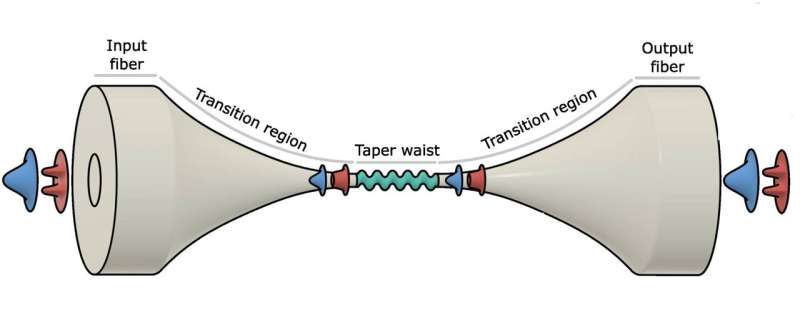Tapered optical fiber addresses challenge posed by Brillouin scattering

When optical beams, consisting of photons, travel through fibers, they cause vibrations that generate acoustic waves, consisting of phonons. The phenomenon, called Brillouin scattering, has been harnessed by researchers to optomechanically “couple” acoustic waves with light waves. This coupling allows information carried by photons to be transduced, or converted, to the phonons, which travel nearly a million times more slowly than light waves.
Opto-acoustic coupling has enabled researchers to read and manipulate the transduced information more easily. To date, however, many of the Brillouin scattering techniques researchers have used rely on standard fiber geometries that cause acoustic waves to die out quickly, limiting the efficacy of the coupling.
Now, using an optical fiber with a micron-sized waist, University of Rochester researchers have demonstrated how to couple propagating optical waves and long-lived acoustic waves, with strong optical-acoustic interactions.
“This is a unique and desirable combination that has not previously been achieved,” says Wendao Xu, a Ph.D. candidate in the research group of William Renninger, assistant professor at Rochester’s Institute of Optics. Xu is the lead author of a paper in Optica describing the breakthrough.
The breakthrough enables information carried by a light pulse to be temporarily stored in slowly propagating acoustic waves long enough for a second pulse of light to “read” the information. The achievement could have applications for light storage, radio-frequency photonics filtering, and optical delay lines.
The research received Best Presentation Award at the WOMBAT 2022 Workshop on Optomechanics and Brillouin Scattering at the Max Planck Institute for the Science of Light, where it was presented by co-author Arjun Iyer, also a Ph.D. candidate in Renninger’s lab.
“Wendao, Arjun, and our collaborators at the University of Tokyo did a great job in demonstrating the promise of this new platform and we are all excited as we begin focusing on next generation devices and real-world applications,” Renninger says.
Brillouin scattering in optical fibers: Overcoming challenges
“The amplitude of the acoustic wave keeps decreasing as it travels,” Xu explains. “Basically, all the high-impact Brillouin scattering that people are dealing with right now produce strong interactions, but the acoustic waves are high in frequency, in the gigahertz range. The higher the frequency, the shorter the wave can actually travel before it dies out.”
Xu’s tapered optical fiber device achieves both strong interactions and longer acoustic lifetimes. It consists of a multi-mode glass fiber with the cladding (coating) removed. By heating the center of the fiber and simultaneously applying mechanical tension to stretch the fiber at both ends, Xu and his collaborators produced a tightly confined, symmetrical “waist” in the fiber.
This waist provides “an ideal optomechanical overlap yielding the strongest Brillouin coupling strengths observed to date from a fiber taper, and comparable to the largest optomechanical coupling strength for any system,” the paper notes.
Moreover, the lifetime of the phonons that the device generates—about 2 microseconds—is long enough that information carried by a light pulse can be temporarily stored in this slowly propagating acoustic wave for a relatively long period of time, before a second pulse of light reads the information.
A tapered optical fiber device
According to Iyer, Xu’s achievement is twofold. “One is the system, the tapered fiber device, which supports an acoustic wave family that people didn’t pay a lot of attention to previously,” he says. “The other is the process itself, using an interaction between two different optical spatial modes to get what we wanted.”
The process—including the physics involved in achieving strong interactions with long phonon lifetimes—could be adapted and applied immediately to improve existing technologies, he says. For example, detecting and filtering out unwanted radio frequencies in photonic filters, or producing fiber-optic transmission delays to compensate for delay differences in optical fiber systems.
The tapered fiber system, on the other hand, while useful for research, is likely too fragile for real world applications outside the lab, Iyer says. “These are micron-sized filaments of glass that are just hanging there,” he says.
However, the researchers are already exploring ways to package the system for real world applications, Iyer says.
More information:
Wendao Xu et al, Strong optomechanical interactions with long-lived fundamental acoustic waves, Optica (2022). DOI: 10.1364/OPTICA.476764
Citation:
Tapered optical fiber addresses challenge posed by Brillouin scattering (2023, February 17)
retrieved 17 February 2023
from https://phys.org/news/2023-02-tapered-optical-fiber-posed-brillouin.html
This document is subject to copyright. Apart from any fair dealing for the purpose of private study or research, no
part may be reproduced without the written permission. The content is provided for information purposes only.
For all the latest Science News Click Here
For the latest news and updates, follow us on Google News.

